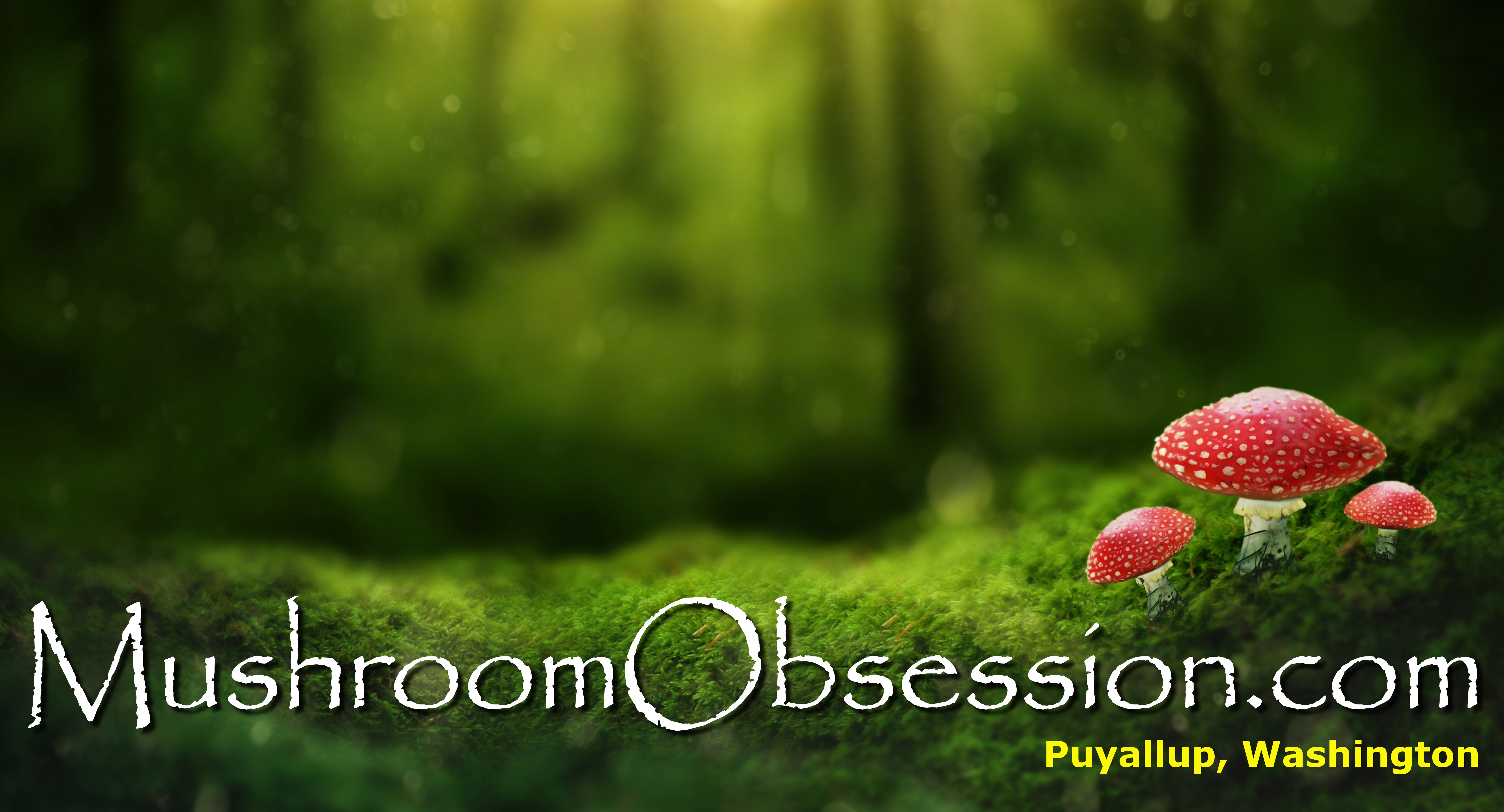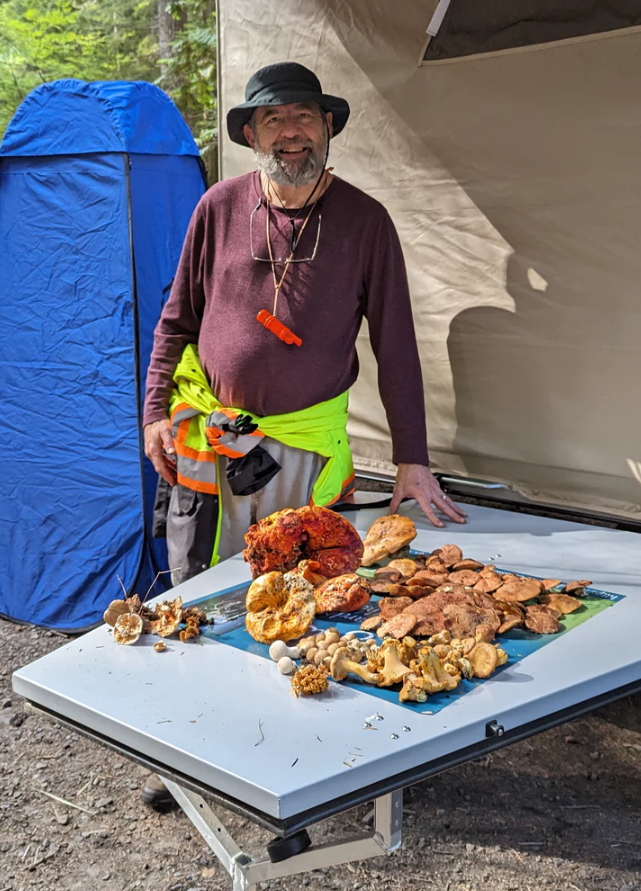Great news! A research foray this week has revealed that many desirable mushrooms are now going in the Gifford Pinchot National Forest. So we are now planning specific foray dates and hope you will be a part.

Here’s what I found in one of my September research forays.
As a reminder: Our mushroom operation is an educational “hobby” business and not designed to generate income. Therefore the forays themselves are FREE. Our goal is to help you understand where the exotic edible mushrooms can be found, and how to identify and hunt for them safely.
We do this through 2-hour forays that focus on hiking safety and positive identification.
Because this is a “hobby” business we ask those who join us to assume any liability for your adventure. (Because we do not make any money on this, we cannot afford liability insurance!) However, that said, we will do our best to keep you and your family safe and to ensure you have a great hunting experience. (We have been hunting in this area for more than 20 years and so have gained a lot of knowledge and experience that will help you get started well.)
Fall 2023 Foray Dates
Now, here are the tentative foray dates (16 of them) that we are planning over the next six weeks. Each is dependent on weather and forest conditions and attendance. (We can support up to 5 individuals per foray … if we don’t get that many reservations for a given foray, we reserve the right to combine groups.) Forays are open to anyone who can do the hiking safely, but you have to reserve your spot in advance and commit to following our guidance.

Come see “Radagast: Mushroom Wizard of the Forest,” Mushroom Obsession’s new off-grid portable basecamp. It’s a one-of-a-kind in the green state of Washington … 100% solar, easily towable, based on a collaboration between GoSun and Camp365.
Each foray (in a specific location in the Gifford Pinchot National Forest, about 1-1/4 hours southeast of South Hill and 15 minutes southeast of Ashford) is scheduled adjacent to a BBQ meal at our basecamp in the forest. Lunch or dinner meals will include burgers (ground sirloin, salmon or chicken), three sides (including exotic edible mushrooms prepared to accompany), and a drink.

MushroomObsession.com research associate Dr. Dave Lingenfelter shows off a large bolete. By the way, Dave says our salmon burgers and sauteed boletes are among the best he’s ever had!
Breakfast will include bacon or sausage and eggs (cheese optional), toast and coffee. We ask for a $10 donation per person per meal, which will include one free “Mushroom Obsession” coffee mug.

Now here is the schedule:
Friday, September 29
Foray 1: 4 – 6 p.m.
Dinner in the forest: 6 – 7 p.m.
Saturday, September 30
Breakfast in the forest: 7 – 8 a.m.
Foray 2: 8 – 10 a.m.
Foray 3: 10 a.m. – noon
Lunch in the forest: Noon – 1 p.m.
Foray 4: 1 – 3 p.m.
Friday, October 6
Lunch in the forest: 1 – 2 p.m.
Foray 5: 2-4 p.m.
Foray 6: 4-6 p.m.
Dinner in the forest: 6-7 p.m.
Friday, October 13
Foray 7: 4 – 6 p.m.
Dinner in the forest: 6 – 7 p.m.
Saturday, October 14
Breakfast in the forest: 7 – 8 a.m.
Foray 8: 8 – 10 a.m.
Foray 9: 10 a.m. – noon
Lunch in the forest: Noon – 1 p.m.
Foray 10: 1 – 3 p.m.
Friday, October 20
Lunch in the forest: 1 – 2 p.m.
Foray 11: 2-4 p.m.
Foray 12: 4-6 p.m.
Dinner in the forest: 6-7 p.m.
Friday, October 27
Foray 13: 4 – 6 p.m.
Dinner in the forest: 6 – 7 p.m.
Saturday, October 28
Breakfast in the forest: 7 – 8 a.m.
Foray 14: 8 – 10 a.m.
Foray 15: 10 a.m. – noon
Lunch in the forest: Noon – 1 p.m.
Foray 16: 1 – 3 p.m.
Requirements for participating
Participants must be between 5 and 89 years of age (exceptions may apply, let’s talk). Minors must be accompanied and monitored closely by a parent or guardian.
All participants must be physically capable of hiking on- and off-trail in moderately strenuous conditions for two hours.
Each participant must secure in advance a (free) hobby mushroom hunting permit from the Gifford Pinchot National Forest Service. (Click here to apply online.) This permit must be in your possession while hunting.
Each participant agrees to hold MushroomObsession.com and its principles harmless (not liable) for any incidental or accidental loss, damage, injury or death incurred during the hunt.
Each participant agrees to retain and consume (in a safe manner, thoroughly cooked and tested first in small quantities) only mushrooms indicated by MushroomObsession.com principles to be safe edibles. We will go through mushrooms you collect and throw out anything not meeting our standards as such.
Each participant agrees to bring any clothing and personal safety items indicated as necessary for safe hunting by MushroomObsession.com principles, and to refrain from bringing any items (such as firearms) that might cause others accidental harm.
Edible (Fall) Mushrooms You Might Be Able to Find and Collect
In abundance right now: Boletes (mostly Slippery Jacks and Fat Jacks, but also some Admirables or King Boletes possible), Golden Chanterelles, Lobsters (Russula brevipes infected by the parasitic fungus Hypomyces lactifluorum), small Puffballs (Lycoperdon), Angel Wings (we advise caution when ingesting, start in small quantities … there are no known negative reactions in North America, but they were popular in Japan until some fatalities occurred), Oysters, and various Club or Coral fungi (edibility varies).
Occasionally also found in our hunting zone: Angel Wings, Hawk Wings, Oysters, White Chanterelles, Sulphur Shelf (Chicken of the Woods), and Porcupine Hedgehogs.
Rarely but occasionally spotted in our hunting zone or adjacent areas: Lion’s Mane (also known as Bearded Tooth Fungus or Bearded Hedgehog), Matsutake (Pine Mushroom), Black Trumpets, and Morels (spring only).
This list is not comprehensive as others are possible. No mushrooms are promised, but the list above is sorted by likelihood of finding these mushrooms. You may also see a lot of mushrooms which are interesting to look at but not 100% identifiable as edibles. We encourage you to take lots of photos of these, but don’t collect.
Note: Some of these mushrooms, most notably Chanterelles, have look-alikes which are not edible. We will help you distinguish between them. Also, some individuals can be allergic even to mushrooms known as commonly edible, so if it’s your first time consuming, we advise you start with small quantities. And always thoroughly cook all wild mushrooms harvested before consuming.
What’s Next If I’m Interested?
Reach out to us here and provide your name and contact information (phone and email), the names and ages of all in your party, and your first, second, and third choice of foray to participate in. (Also please let us know if you will be joining us for the associated meal in the forest.) And let us know of any questions you might have.
We will reply promptly with confirmation of your reserved foray date, a location and directions to our basecamp in the forest (accessible on a gravel Forest Service road which is suitable for most two-wheel drive vehicles), and refer you to the list of what to bring to help ensure your safety while hunting, which can be found below.
Note: There is no cell phone signal in our immediate hunting zone, although signal access exists for most networks only about a quarter mile to the southwest of our basecamp. We also utilize a GPS-based channel which provides immediate satellite access to emergency services in the forest. Our hunting zone is at an altitude of approximately 2,000-2,500 feet above sea level.

We will provide weather estimates closer to the date of the foray.
What to Bring for Your Comfort, Safety, and Enjoyment
Check the weather forecast for the Ashford area, subtract 5 degrees (as we are a little higher in elevation and in an area with a lot of trees and undergrowth), and dress accordingly (preferably in layers). We advise sturdy, waterproof shoes or hiking boots, covering your arms and legs, and a hat which prevents tree debris from dropping down around your neck. Lightweight gloves may also be advisable. (We don’t typically have many problems with insects, but as we occasionally run into nests of small ground wasps, mosquitoes, or biting black flies, you may wish to bring insect repellent.)
Wear bright colors (orange, yellow, flourescents, etc.) to distinguish yourself from prey (bears and deer, primarily) occasionally sought by hunters in the area.
Many find a walking stick handy for moderately challenging terrain, and a light backpack for carrying gear in addition to your mushroom basket.
Sturdy woven baskets serve best as mushroom collection containers, as they allow mushroom spores to re-seed the ground you are walking on. There is a maximum 2-gallon limit for mushrooms collected with a hobby permit.
We advise a sharp knife for cutting mushrooms off at the base (stipe) just above the soil. We practice “leave no trace,” so be sure to pack out anything you bring in.
Think in terms of: What would I need if I got lost in the forest and had to survive overnight? Here is a possible list:
- Clean drinking water (at least 32 fluid ounces) or a filtered bottle for accessing water from streams.
- Any medicines you need or first aid that might come in handy.
- An emergency reflective blanket.
- A light source (good flashlight).
- A noisemaker (sharp whistle).
- A compass and/or GPS for finding your way back to the trail. And a fully-charged cellphone (although you may or may not get a signal).
In our hunting zone, getting lost (for more than an hour) is extremely unlikely … but not impossible. We will conduct a quick briefing at the beginning of the hunt about how NOT to get lost, and what to do (or not do) if you DO get lost.
Other possible hazards to be aware of in our hunting zone:
- Other hikers and hunters. Be courteous, highly visible, and stay aware. It’s generally not legal to shoot firearms in the forest but occasionally people are out there doing target practice. If you hear shooting, stay away and make lots of noise.
- Wild animals: In 20 years of hunting, while we have seen evidence of black bears and mountain lions, we have never seen an actual specimen. They are normally quite bashful and will steer well clear of people, particularly if you are making plenty of noise. If you do see one, DON’T RUN, just make yourself look as large as possible, shout loudly or blow your whistle, and back away slowly.
- There are no poisonous snakes in this part of the country, and few poisonous insects. Wasps are about the worst of it.
- Rabies is always a possibility if you happen to get bit by a bat, rodent or other animal, so seek medical attention immediately if this happens.
- Accidents caused by rough terrain or falling trees. This is probably the most likely possible cause of injury, so mind where you step and exercise caution while hiking. Also be sure to keep your mushroom knife carefully sheathed while you are moving about.
- And please drive safely to and from our basecamp! Your greatest risks will always be on the highway.
We hope you will join us for an upcoming foray!


Leave a comment